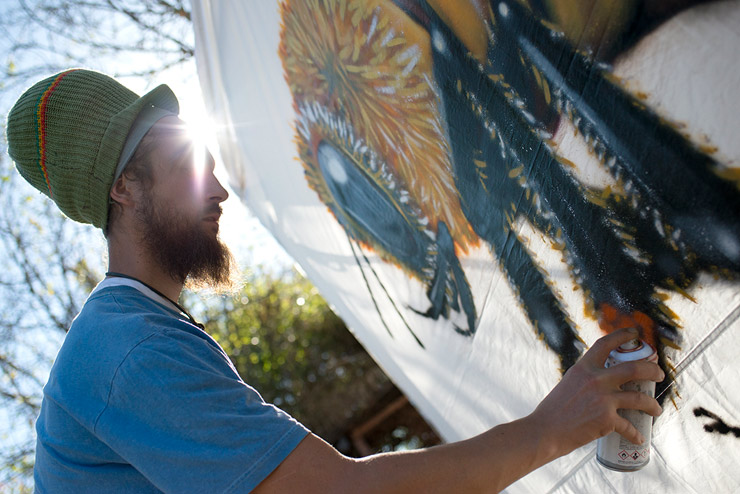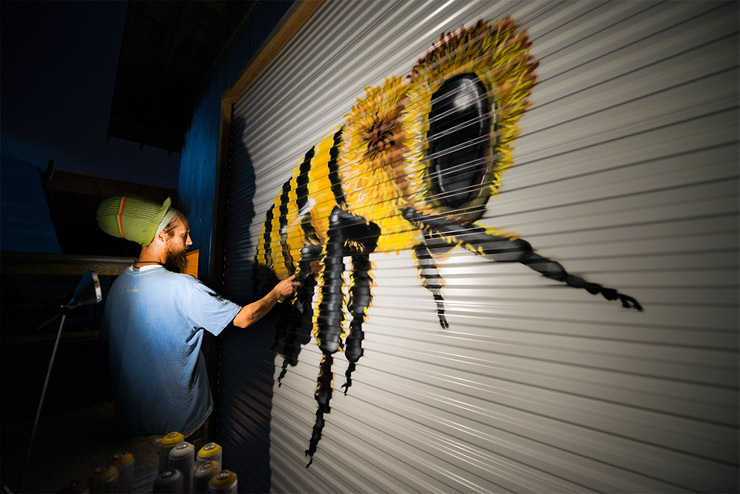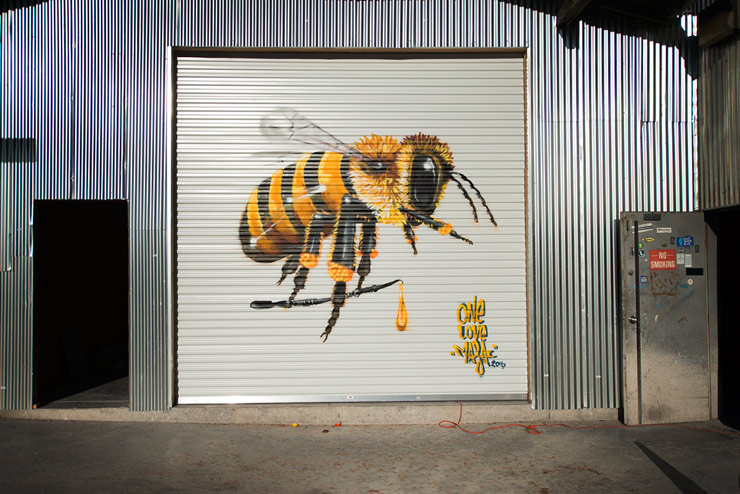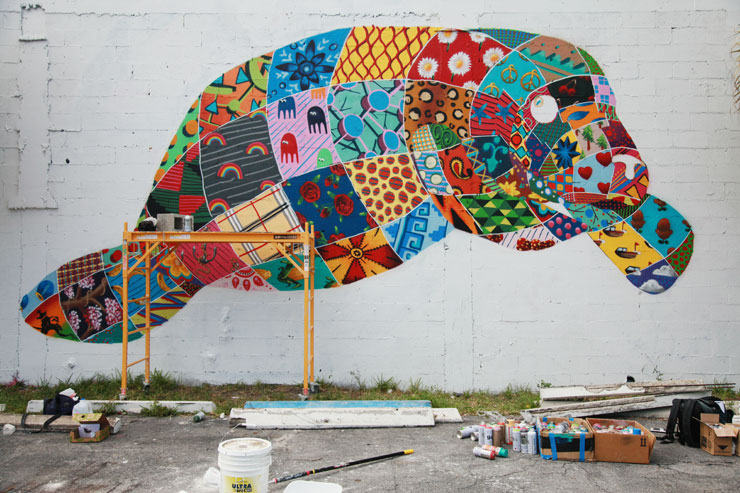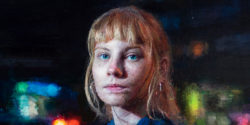9 weeks, 8,000 miles, 20 murals, 13 cities.
Dozens of species going extinct every day.
Those are some telling statistics for Street Artist Louis Masai as he completes criss-crossing the United States during this moment when it looks like the country is on the precipice of a social and political revolution.

Louis Masai painting in Oakland © @
At a time when industries and media are consolidating under ever larger private umbrellas that seem unassailable it is all the more striking to witness the audacity of the single crusader, like this one with a spray can, that may prove to be very inspirational. It’s difficult to imagine the willpower of one person to devise an educational campaign like this and then to raise funds to pay for it and use his artistic talents to raise awareness in this manner.
It may strike you that endangered species are an appropriate constituency to speak for since they have no voice of their own, and Masai says the bee is the queen that lead him on with two friends in October, November and part of December. With his thoughtful, studied and “chill” stance on many topics, it sounds charming when the London-based artist tells you his campaign is called “The Art of Beeing.”

With a metaphorical protective patchwork quilt being stitched by the bee around a different animal in each mural, Masai carefully researched and chose endangered animals that are specific to the region he painted in from New York to Detroit to Nevada to California to Texas to Tennessee to Miami. We had the honor to meet him at the start of the journey and at the termination, and to publish as many of his travels as his schedule would allow.
Today we compile a quote and a couple of images from each one of those on-the-road reports below with links to each posting.
We finish our complete coverage of “The Art of Beeing” with a 15 question interview with Louis, who tells us about his personal attachment to the animal world, the startling and gorgeous geography of the US, and which populations seemed most receptive to his message of the Earth’s sixth era of extinction that we are currently engendering.
Thanks for taking this trip with us.
NEW YORK
Louis Masai: “The Art Of Beeing” Tour Kicks Off in NYC to Save Endangered Species
“I’m painting toys because if we don’t act now to stop extinction, only toys will remain in place of animals”
– LM
Louis Masai: The Art of Beeing USA Tour. The Bushwick Collective, Brooklyn. NYC. October 2016. (photo © Jaime Rojo)
Louis Masai: The Art of Beeing USA Tour. Bog Turtle. Endangered. The Bushwick Collective, Brooklyn. NYC. October 2016. (photo © Jaime Rojo)
Louis Masai: The Art of Beeing USA Tour. New England Cottontail Rabbit. Vulnerable. The Bushwick Collective, Brooklyn. NYC. October 2016. (photo © Jaime Rojo)
DETROIT
The Gray Wolf and “The Art Of Beeing” in Detroit
“The media talks about Detroit as if it is a derelict forgotten city, but we discovered a whole community that has been here for a long time and they definitely wouldn’t agree with their city is a dead or abandoned space,”
– LM
Louis Masai The Art Of Beeing. Gray Wolf. Endangered. Detroit. Michigan. October 2016. (photo © @teebyford)
Louis Masai The Art Of Beeing. Gray Wolf. Endangered. Detroit. Michigan. October 2016. (photo © Louis Masai)
RENO
Cutthroat Trout & “The Art Of Beeing” in Reno, Nevada
“After 4 days of driving from Detroit to Reno we felt empowered by the incredible landscapes we had driven through, from salt lakes to deserts and the Rockies, not one part of the trip was unexciting,” says Louis Masai of the journey. “Well perhaps the 7 hours of corn fields.”
-LM
Louis Masai The Art Of Beeing. Lahontan Cutthroat Trout. Endangered. Reno. Nevada. October 2016. (photo © Mia Hanak)
Louis Masai The Art Of Beeing. Lahontan Cutthroat Trout. Endangered. Reno. Nevada. October 2016. (photo © Louis Masai)
SACREMENTO
Jumping Salmon! Louis Masai is in Sacramento. “The Art Of Beeing” Tour
“We drove through snowy mountains from Reno to Lake Tahoe, and then descended a continuous downwards road for 6000 feet – which took about an hour to get into Sacramento,” he says. “What an incredibly diverse landscape! It’s just mind-blowing.”
-LM
Louis Masai The Art Of Beeing. Coho Salmon. Endangered. Sacramento, California. October 2016. (photo © Louis Masai)
Louis Masai The Art Of Beeing. Coho Salmon. Endangered. Sacramento, California. October 2016. (photo © Louis Masai)
SAN FRANCISCO
Louis Masai: Onward Ho! To San Francisco with “The Art Of Beeing”
“We met some amazing beekeepers in San Francisco that really opened up this idea that nature and the engagement with nature can definitely start to generate a sense of love for oneself and the environment”
– LM
Louis Masai The Art Of Beeing. Island Fox. Near Threatened / California Channel Islands. San Francisco, CA. October 2016. (photo © @lmnotree)
Louis Masai The Art Of Beeing. Island Fox. Near Threatened / California Channel Islands. San Francisco, CA. October 2016. (photo © @lmnotree)
Louis Masai The Art Of Beeing. Honey Bee. Jetty extracts Oakland. San Francisco, CA. October 2016. (photo © @lmnotree)
Louis Masai The Art Of Beeing. Honey Bee. Jetty extracts Oakland. San Francisco, CA. October 2016. (photo © @lmnotree)
LOS ANGELES
Louis Masai, Leaping Frogs and Crawling Crayfish in LA : “The Art Of Beeing”
“I painted the Shasta crayfish (or as Americans call it; crawfish) in Venice, an endangered species native to northeast California There are only seven remaining populations of the Shasta crayfish left and are found only in Shasta County, California, in the Pit River drainage and two tributary systems, Fall River and Hat Creek drainages,”
-LM
Louis Masai: The Art of Beeing USA Tour. Yellow Legged Frog. 90% have disappeared in the last 100 years. Downtown, LA. November 2016. (photo © Lmnotree)
Louis Masai: The Art of Beeing USA Tour. Yellow Legged Frog. 90% have disappeared in the last 100 years. Downtown, LA. November 2016. (photo © Louis Masai)
Louis Masai: The Art of Beeing USA Tour. Shasta Crayfish. Critically Endangered. Venice, LA. November 2016. (photo © Lmnotree)
Louis Masai: The Art of Beeing USA Tour. Shasta Crayfish. Critically Endangered. Venice, LA. November 2016. (photo © Tee Byford)
PHOENIX
A Jaguar in Phoenix: Louis Masai and “The Art Of Beeing”
“It’s always hard to formulate too much of an understanding of a city when you are only there for a very short time…and I guess a lot of this trip has been that way, but even more so in Phoenix, with only two nights and one day.”
-LM
Louis Masai: The Art of Beeing USA Tour. Jaguar. Only 15K remain in the wild. Phoenix, AZ. November 2016. (photo © Emil Walker)
Louis Masai: The Art of Beeing USA Tour. Jaguar. Only 15K remain in the wild. Phoenix, AZ. November 2016. (photo © Louis Masai)
TEXAS & TENNESSEE
Flying Squirrels and Houston Toads : Louis Masai
“I guess the attraction is the abundance of frats and bar culture in the area. I got to know a handful of these homeless folks over the five days this mural took to complete and I can definitely see that the new mural in their neighborhood gave them some new color and appreciation in their lives. Several vowed to protect its longevity, bless them.”
-LM
Louis Masai: The Art of Beeing USA Tour. Houston Toad. Endangered. Austin, TX. November 2016. (photo © Emil Walker)
Louis Masai: The Art of Beeing USA Tour. Houston Toad. Endangered. Austin, TX. November 2016. (photo © Emil Walker)
Louis Masai: The Art of Beeing USA Tour. Northern Flying Squirrel. Endangered. Nashville, TN. November 2016. (photo © Emil Walker)
“The wall that I painted shadows a section of the city that I am sure will get pushed out. Men hang out on the street not doing much; we met a cowboy inspired gentleman that was proud to admit to eating gopher tortoise – a federally protected species. He said he had three in his freezer…he grew up eating what they hunted, from squirrels to rabbits and tortoise. Hopefully my line of work can help to steer people away from eating these species.”
Louis Masai: The Art of Beeing USA Tour. Northern Flying Squirrel. Endangered. Nashville, TN. November 2016. (photo © Emil Walker)
ATLANTA
The Box Turtle in Atlanta: Louis Masai and “The Art Of Beeing”
Louis Masai: The Art of Beeing USA Tour. Box Turtle. Critically Vulnerable. Atlanta, GA. December 2016. (photo © Tee Byford)
Louis Masai: The Art of Beeing USA Tour. Box Turtle. Critically Vulnerable. Atlanta, GA. December 2016. (photo © Tee Byford)
MIAMI
A Manatee, A Crocodile and a Heart of Coral in Miami: Louis Masai and “The Art Of Beeing”
“Well its not my first time to Miami for Basel, so I know what I’m heading into…and actually I think that because I was there doing my own thing and for my own reasons, i.e. the tour, things were a lot easier for me. I also had linked up two good people, the Raw Project and Bushwick Collective so the ride was smooth.”
-LM
Louis Masai: The Art of Beeing USA Tour. Manatee. Vulnerable. Miami, FL. December 2016. (photo © Jaime Rojo)
Louis Masai: The Art of Beeing USA Tour. Manatee. Vulnerable. Miami, FL. December 2016. (photo © Jaime Rojo)
Louis Masai: The Art of Beeing USA Tour. Manatee. Vulnerable. Miami, FL. December 2016. (photo © Tee Byford)
Louis Masai: The Art of Beeing USA Tour. American Crocodile. Vulnerable. Miami, FL. December 2016. (photo © Jaime Rojo)
Louis Masai: The Art of Beeing USA Tour. American Crocodile. Vulnerable. Miami, FL. December 2016. (photo © Emil Walker)
Louis Masai: The Art of Beeing USA Tour. Coral. Threatened. Miami, FL. December 2016. (photo © Louis Masai)
Louis Masai: The Art of Beeing USA Tour. Coral. Threatened. Miami, FL. December 2016. (photo © Louis Masai)
An interview with Louis Masai about “The Art of Beeing”
Brooklyn Street Art: Can you share with us a memory or a story from your childhood relating to a pet or an animal or animals that made an impact on you and stayed with you for the rest of your life?
Louis Masai: Ever since I can remember I have felt strong emotions towards animals, we had family pets and all of them became very good friends of mine…however my love for the animal kingdom was far deeper than that. For me spirit animals are very real and I have always felt a huge connection towards lions. I admire their strength, charisma, loyalty, stubbornness, and of course leadership. Those that know me well will know that, I myself share a lot of those traits. Now that I grow older I realize that a spirit animal can’t be chosen and in fact it chooses you, some might say that the bee has chosen me.
Brooklyn Street Art: How did that story inform your growth into adulthood?
Louis Masai: Well I guess the idea of spirit animals has stayed with me into adulthood and become something that I understand in a different kind of way than when I was younger. For me the relevant difference in mindset, is that I realize that life finds you. When you look for something too hard or try and orchestrate a result, the journey might not be as fulfilling as if life is allowed to lead the way. I see one chapter lead to the next in a very organic manner. I evolve as an artist in the same way allowing for one idea to develop into the next.
Brooklyn Street Art: What do you think drives humans to destroy what sustains them? It is as if we are killing ourselves slowly by killing what gives us life and keeps us alive in the first place.
Louis Masai: Mmmmmmm…I’m not so sure that I think it’s a drive, perhaps there are agendas that drive humans towards destruction, for example money, but I don’t believe that its actual destruction itself that motivates this unsustainable lifestyle we live. Ultimately its the average person who populates the majority of this planet. I would be inclined to believe that the majority of this demographic have little understanding of what words like finite, extinction, deforestation etc result in. It’s only when I talk to scientists, environmentalists, or activists that I manage to find a true understanding of what we face ahead of us.
Here I am sat at a laptop with my, iPhone in company and a disposable bottle of water on a train, speeding towards Birmingham for Christmas. The minerals in my laptop and phone are finite and the plastic in that bottle is extremely likely to end up in the ocean, or at the very least spending the next 450 – 1000 years biodegrading on a landfill. Ultimately we are uneducated and in denial. If everyone used water filter bottles instead of bought disposable plastic bottles in the developed world alone, the ocean and what survives from its wealth would be hugely affected and in a positive way.
Equally we should be looking at how to extend the lifespan of our smart phones and laptops, its not very smart to run out of the rare earth minerals that makes them work. And even less smart to not know what impact that lack of mineral will have on the planet itself. I have so much to talk about with regard this question…where I will conclude is that I have a personal belief. I believe nature doesn’t make mistakes and that the destruction of the current stage in the earth’s life cycle is what nature has intended for us.
I feel that perhaps given that humans are one of the youngest additions to the planets kingdom and we have become the most destructive, that we are only doing what is required of us. Geographically, we are thousands of years overdue a shift in the planets alignments and I have this idea that nature allowed humans to be so dominant, only to help her speed up this change… so who else is looking forward to the new iPhone then?
Brooklyn Street Art: Did you have any expectations or anxieties as you started your tour in NYC?
Louis Masai: Eeeeeeesh, well it was a huge expectation from the three of us, and I knew that from the beginning. So with that in mind, based purely on my acceptance for organic flow I definitely had my concerns, but I didn’t have anxieties. I think that any artist who is painting in the public domain, within communities, will always have a slight element of reservation. I know that if I didn’t, then it would be a case of not caring enough about where I was leaving my work. The last thing I want is for my work to be undesired, especially given that it comes with an environmental point of urgency. But as for the nine weeks of intense work within confined spaces, filming and editing 5 films, driving across 8000 miles, to paint 20 murals in 13 cities…piece of cake!
Brooklyn Street Art: Yours was an art tour but it also was a round road trip, across the USA from the East to the West and in reverse in the company of your team, which included your videographers, Emil Walker and Tee Byford. What was the hardest part of the road trip?
Louis Masai: Yeah it certainly was never intended to be just a painting tour, there is only so far that a painting can direct influence and it’s our belief as a team that film can create a new chapter for the project. 5 mini docs were filmed and edited as we traveled across the states, each discussing new issues with the people and scientists that we met along the way.
I think that purely based on the fact that I’m used to not really knowing where I’m always going to paint and being able to foresee that element, creating the murals wasn’t really the hardest part. I would definitely say that the editing and creating five engaging films proved the most complicated. All the interviews were found whilst we were traveling with exception of only a few, so that in itself was a task.
Brooklyn Street Art: Did you have a preconceived idea of what you were going to paint in each city and if so did you change your plans/animals as you drove across the country?
Louis Masai: So…as we traveled I also was editing the website to keep the public up-to-date with our progress. Within the website is information about each species and what the general public can also do to help the endangered species out, a call to action. Before I left London I had already selected species for each city that we would travel through, within that list I had double what I needed for completion, that was purely so that I could negotiate with building owners and also switch species in accordance to the composition. There are still a good number of species on that list in the website to be created, I’m sure I will be back to the states in the coming years to complete that list.
Brooklyn Street Art: How was it driving from state to state and city to city in regard to experiencing the variations in culture, attitudes and accents from the people whom you met as you drove across?
Louis Masai: Its mesmerizing, no in fact there is no word that I know of, that justly describes the intense, awe-inspiring beauty of the landscape. That alone is a reason to preserve and encourage the masses to realize what they have before it’s too late. Within each of these ever changing landscapes or screen-savers as we called them, are some of the kindest, and humble of spirits I have met in a long time. However there is always shadow to the light and of course there are also some of the most narrow-minded bigots.
We did indeed meet the many faces of the states from native Indians to illegal aliens; freeway fireworks shop owners to Detroit poets. If I was to generalize purely based on our nine week experiences, the east is very unaware of the environment, the west coast is very awake and starting to take action, the south is in total denial and the middle Americas we drove through seem very detached. Given that we spent so much time on the road – inside a car, I would have to say; that the cars you share the roads with in America definably act as indicators as to how that state thinks about its carbon footprints.
Brooklyn Street Art: In Detroit you discovered a vibrant city with deep rooted and kind citizens but you also witnessed nature taking over the abandoned parts of the city and in fact that’s a good thing for the bees. Can you talk a bit more about that?
Louis Masai: Well the movie world has certainly created many times over, a very good image of what an abandoned city could look like. That city is not Detroit. Of course it has many fallen and crumbled factories, but there aren’t trees growing through the structures or bears and wolves occupying the city. Instead, the people who have remained in the city and the many that have moved to Detroit have returned to backyard horticulture and that alone has changed the dynamics of the people who inhabit this city.
We met many people within Detroit who gave us first-hand accounts of how they are a part of this DIY culture. That was never more evident than when we met Joan from City Bees. She pointed out that the best habitat for bees is one where lots of native wild fauna is left to grow and humans are not interested in disturbing it. Detroit is exactly that to the many bees and their keepers that live there.
Brooklyn Street Art: In San Francisco, besides painting you also attended the Bioneer Conference. At the end of the conference did you walk out of it feeling more hopeful or less hopeful for the environment? What new radical thing did you learn that people talked about during the conference?
Louis Masai: Ah man…where do I start, I’ll be honest with you, it’s not looking so great. Devastation is happening on a worldwide scale, climate change is in effect. The ice caps are melting, sea levels are rising, ocean temperatures are increasing, coral reefs are dying, plastic is destroying the ocean, species are disappearing – consistently, climate change refugees still don’t have any rights and way too many leading corporations are running the planet for their own benefits… but, hey… we have known that was the cards on the table since before the 70s.
The difference is that now it’s really actually happening, and faster than anticipated. What I learnt at Bioneers is that humans are resilient and that there are many people out there who do care enough and we can turn things around, but only if we all start today. I urge everyone to pick one environmental issue to tackle a month. Before you know it, being conscious could become a part of your daily routine…three good issues to try and tackle are;
-
Palm oil – just don’t buy it.
-
Consumption of all cow products (everything with secret ingredients too) – if you can’t eradicate it, half it.
-
Plastic – recycling ain’t cutting it, stop buying it, and if you can’t eradicate it from your weekly shopping at least lose some of it – veggies come without plastic cellophane too you know!
To understand more about the current situation, check out these films…Racing Extinction, Cowspiracy, and Before The Floods. Don’t take them for gospel, do some research around the topics but if everyone picks something and activates their life in conjunction with that, we could fix this mess we are in…of course fixing politicians and politricks is another story…
Brooklyn Street Art: In Phoenix you talked with a Native American named Breeze and the conversation touched on the topic of “the lack of respect” for our planet. Do you think that this “lack of respect” is a result of our public education systems being decimated by budget cuts and capitalism running amok in our societies?
Louis Masai: Well I think that there are strong possibilities that this is one reason, but I’m not one for believing that school is the only place we learn. I have learnt more about respecting the environmental long after my time at school than I ever did whilst in school. I also had pretty cool parents who didn’t do the NORM, so my widened perspective of life and what goes on around me was in part their doing.
I also think that lack of respect is something that has been amidst the American settler way before any kind of budget cuts existed, you have only to look at the culling of the buffalo to see that. It’s the responsibility of my generation to make sure that the youth are learning about respect with or without cuts in the education system.
In my opinion, the system that is being really abused is our eco-system, I’m not sure we need to make any excuses as to why we are showing it a lack of respect; we just need to fix up.
Brooklyn Street Art: Did you ever experience hostility from some of the residents of the cities or a city where you painted?
Louis Masai: Yeah in New York, it was the second wall, the bog turtle. A disheveled looking guy who I think lived inside a warehouse in Bushwick, took a dislike to us. He shouted some abuse on the eve of the first night to which we ignored but on the second day he picked up from where he left off, so I confronted him.
By the time I had reasoned him, amidst his highly abusive claims and insults he returned an hour later for a hug and cuppa coffee…all is well that ends well. Other than that we were blessed from one city to the next with awesomeness. Oh…except in San Francisco, we fell victim to the everyday car smash and grab…
Brooklyn Street Art: You were in the middle of the tour when the presidential election took place. Was there a before and after in regards of energy and on enthusiasm from the residents? Did you notice a change of the mood?
Louis Masai: I knew when I was planning the tour that the elections would be happening and I knew that there was little if any evidence to show any regard for the environment from either candidate. I also had a strong saddened gut instinct that the result would be as has become. I’m very sorry for what is still to come. And it’s not America alone that is falling victim to this domino effect of politicians.
We definitely were in company of many anti-Trump supporters throughout the tour, but we did spot the supporters; from shops, to car bumper stickers. Did it change the mood, sometimes yes, but for the most part as we were in company of such awe-inspiring people and non-supporters of Trump I can’t say it affected us too much. But of course we discussed it solidly for two months.
Brooklyn Street Art: In Nashville a resident confided to you that he actually hunts and eats and endangered and federally protected tortoise. Did that make you angry? What were your reaction and your approach?
Louis Masai: Furious…and I reached out to my contacts as to what to do about it; there was a mixed response. I’m still to reach my decision as to what to do but I’ll probably send his information directly to the species protection society. He didn’t seem like an evil man, just one that grew up surviving eating what his family could salvage from the woods and that’s what he has grown up to continue doing. I suppose in many ways its no different form eating cows and chickens…
Brooklyn Street Art: In Miami you bartered your art in exchange for accommodations. The Aztecs didn’t have minted currency, yet they were an empire. They bartered goods and services in an enormous open market in their capital city. Do you think bartering could make a popular come back in our civilizations to the point that it could make social impact in the markets?
Louis Masai: Not a chance unfortunately. And the biggest reason for that is everyone perceives something’s value differently. Even with the painting I did for the Miami accommodation it wasn’t a simple task of, I do a painting you provide a room. I emailed about 50 air BNB establishments before I got lucky and the logistics of what that lucky find perceived the value of what I was painting, was very different to what he valued his own accommodation to be.
Bartering is very complicated and in many ways money is much simpler because we all need the same object, we just swap different items or services for that object. With bartering most of the time the object in question is not desired by one of the bartering members. That being said, I love swapping and would happily welcome anyone to strike a swap with me…
Brooklyn Street Art: Is there something more personal you might want to share with us about your experience driving and painting across the United States?
Louis Masai: Well I would like to give massive props to Emil and Tee for maintaining a vegan diet for 9 weeks. For me that’s my diet anyway, but for the tour the boys accepted the challenge to be vegan. It wasn’t easy at times, and humus/salsa/salad/avocado wraps definitely don’t need to be on the menu for a bit.
For me it was important to do this as it sets an example of how an environmental idea played out can have impacts. Of course just two extra vegans for two months has a low impact but imagine 200, one week out of every month over a year, that makes impacts and the challenge opened that up as a discussion with the people we met along the way. We actually converted the concept to a handful of people, so it’s worked out.
America as it happens is incredibly good at catering for vegans, I guess that’s mainly because people don’t cook at home in the states. Thumbs up America!
Louis Masai The Art Of Beeing on The Huffington Post

For for more information regarding The Art Of Beeing click HERE
Other Articles You May Like from BSA:
SOS ! The Earth is increasingly sending out this message. And increasingly artists are answering the call As we near the end of 2018 we feel indebted to Street Artist / fine artist/ activist Ernest Za...
64% of Americans are living paycheck-to-paycheck, China and Russia are buddying up, BRICs countries are looking for new members, and the Bankers in your life are again looking toward their gilded...
Before we lose the warmth of the sun we wanted to reflect on one of the largest graffiti shows curated under one theme that was mounted this summer right on the streets of Brooklyn by members of the l...
“The Basque Government is about to start the procedure for awarding the 104 homes in the subsidised housing project that will be located on Zorrotzaurre plot SI-2,”says the website for the biggest de...
Transfigurative. Transmutative. Transformative. Welcome to Manyak’s world. Manyak in collaboration with L’association Art Azoï. Paris, France. (photo © Michele Garnier) The Paris-based graff...
 BROOKLYN STREET ART LOVES YOU MORE EVERY DAY
BROOKLYN STREET ART LOVES YOU MORE EVERY DAY